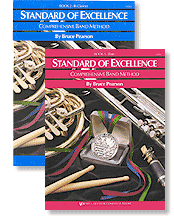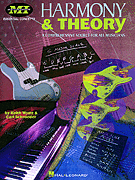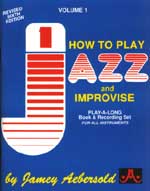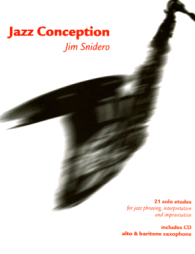Allen Cole: Teaching Curriculum
The curriculum is goal-oriented, and these goals occur on
several levels. The primary goal is the enjoyment of music over the student's lifetime. To
achieve this, we must reach the subgoals of competence on the instrument, and familiarity
with the mechanics of music itself. Competence on the instrument is achieved through
skillbuilding subgoals such as learning the various scales, working exercises and etudes,
playing duets and preparing solos. The familiarity of musical mechanics is achieved mostly
through the study of Music Theory. Many of the technical and skillbuilding activities in
my curriculum have been designed to reinforce the student's theory knowledge as well as
his/her playing ability. This is done by using the best teaching materials available, and
by supplimenting commerical materials with additional materials of my own. Students
contribute to this also by writing out some of their more basic technical exercises. This
conditions them to the kind of self-reliance that performing artists must have to unleash
their own creativity, and gives them practical experience in a number of things that would
be hard to learn on an intellectual level alone.
 Beginners generally start off playing by
ear. Most have had recorder in school, and the fingering is very close to that of the C
scale on Sax and Flute, and the low F scale on Clarinet. This activity has several
purposes. First, it gives the student the gratification of actually being able to play a
song in the first lesson or two. Second, it empowers them to explore music on their own
and discover for themselves the necessity of the other skills to be learned. Third, it
helps to solidify hand and finger position before bad habits can be formed.
Beginners generally start off playing by
ear. Most have had recorder in school, and the fingering is very close to that of the C
scale on Sax and Flute, and the low F scale on Clarinet. This activity has several
purposes. First, it gives the student the gratification of actually being able to play a
song in the first lesson or two. Second, it empowers them to explore music on their own
and discover for themselves the necessity of the other skills to be learned. Third, it
helps to solidify hand and finger position before bad habits can be formed.
Parallel study in the Master Theory Workbook teaches them the basics of
reading music and counting rhythms. They can also reinforce their knowlege of notes on the
staff by writing down the pitches of the songs they play by ear. Once some basic counting
ability is established, beginners settle in for their primary curriculum--the first two
volumes of Standard of Excellence. Play-along CDs are employed, and used--along
with theory--for problem solving and playing discipline.
Intermediate Students continue into the second volume of Standard
of Excellence, followed by the Rubank Intermediate Method for their
instrument. Duet and sight-reading books are added to the curriculum. Students play
duets with the instructor and with themselves via tape. Duets are selected to highlight
both independent playing and the art of harmonizing. Sight-reading is done in the
WB/Belwin Tunes for Technic books, which also introduces them to a world of
common-knowledge songs. Compact, memorized scale studies are introduced with the purposes
of solidifying technique, increasing comfort when playing by ear, and preparing the
student for All-District band auditions.
Advanced Students diverge into methods that are traditional for their
instrument. Pieces from the instrument's classical reperatoire may also be studied.
More advanced duet and sight-reading books are employed, as well as etude books. A new
generation of compact, memorized scale workouts is employed to hammer in proper technique,
aid in problem solving, and provide a basic standard of competence. Students write these
exercises themselves by transposing from an example
document given to them. Advanced theory (harmony & arranging) and Jazz
Improvisation are available at the student's option.
 Basic Theory Curriculum consists of Master
Theory Workbook volumes 1-3. This focuses on notation, counting rhythms, key signatures
& scales, hearing scales and intervals, basic chords and two-part harmony. Final
competency is to play a simple song by ear, write it down, add a parallel harmony part,
and select guitar/piano chords to go with it. This is required of all students.
Basic Theory Curriculum consists of Master
Theory Workbook volumes 1-3. This focuses on notation, counting rhythms, key signatures
& scales, hearing scales and intervals, basic chords and two-part harmony. Final
competency is to play a simple song by ear, write it down, add a parallel harmony part,
and select guitar/piano chords to go with it. This is required of all students.
 Advanced
Theory Curriculum (optional) In order to keep theory study relative to the
playing of band instruments, I put advanced theory students into Harmony and Theory, from
the Musicians Institute Press. Here, they deal with harmony and melody issues in the
environment and language where they're most likely to need them--in the field of pop music
and jazz.
Advanced
Theory Curriculum (optional) In order to keep theory study relative to the
playing of band instruments, I put advanced theory students into Harmony and Theory, from
the Musicians Institute Press. Here, they deal with harmony and melody issues in the
environment and language where they're most likely to need them--in the field of pop music
and jazz.
I have dropped the use of Master Theory Books 4, 5 & 6 because classical theory is
available as a credit course in most high schools, and its nomenclature is different from
what the student will find in the very circumstances where they need their theory the
most.
Students who don't have good piano keyboard skills are encouraged to use software such
as Noteworthy Composer to assist them with
their advanced theory.

 Jazz
Improvisation Curriculum (optional) is itself largely improvised. Students use How
to Play Jazz and Improvise (Jamey Aebersold Vol.1) as the core text. Emphasis is on
improvising by ear, using basic scales. Students learn and transcribe jazz songs and solos
by ear from recordings. They also learn about various song forms, and standard chord
progressions. Jazz/swing style is learned through Jazz Conception by Jim Snidero
and exercises in the Basic Jazz Conception for Saxophone books by Lennie Niehaus.
Jazz
Improvisation Curriculum (optional) is itself largely improvised. Students use How
to Play Jazz and Improvise (Jamey Aebersold Vol.1) as the core text. Emphasis is on
improvising by ear, using basic scales. Students learn and transcribe jazz songs and solos
by ear from recordings. They also learn about various song forms, and standard chord
progressions. Jazz/swing style is learned through Jazz Conception by Jim Snidero
and exercises in the Basic Jazz Conception for Saxophone books by Lennie Niehaus.
Other course material here is provided by the instructor. Cassette tapes, transcribed
solos, etc.
Back to Private Music Lessons Back to Professional Services Home Email me
 Basic Theory Curriculum consists of Master
Theory Workbook volumes 1-3. This focuses on notation, counting rhythms, key signatures
& scales, hearing scales and intervals, basic chords and two-part harmony. Final
competency is to play a simple song by ear, write it down, add a parallel harmony part,
and select guitar/piano chords to go with it. This is required of all students.
Basic Theory Curriculum consists of Master
Theory Workbook volumes 1-3. This focuses on notation, counting rhythms, key signatures
& scales, hearing scales and intervals, basic chords and two-part harmony. Final
competency is to play a simple song by ear, write it down, add a parallel harmony part,
and select guitar/piano chords to go with it. This is required of all students. Beginners generally start off playing by
ear. Most have had recorder in school, and the fingering is very close to that of the C
scale on Sax and Flute, and the low F scale on Clarinet. This activity has several
purposes. First, it gives the student the gratification of actually being able to play a
song in the first lesson or two. Second, it empowers them to explore music on their own
and discover for themselves the necessity of the other skills to be learned. Third, it
helps to solidify hand and finger position before bad habits can be formed.
Beginners generally start off playing by
ear. Most have had recorder in school, and the fingering is very close to that of the C
scale on Sax and Flute, and the low F scale on Clarinet. This activity has several
purposes. First, it gives the student the gratification of actually being able to play a
song in the first lesson or two. Second, it empowers them to explore music on their own
and discover for themselves the necessity of the other skills to be learned. Third, it
helps to solidify hand and finger position before bad habits can be formed.


